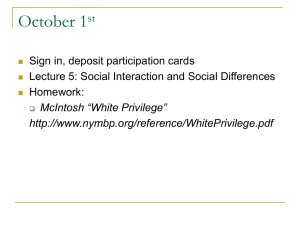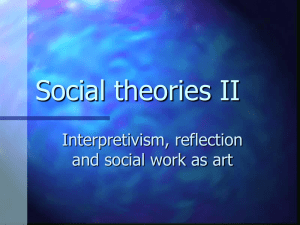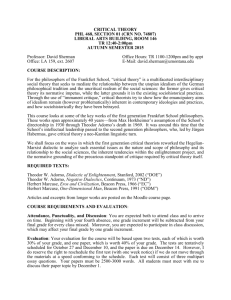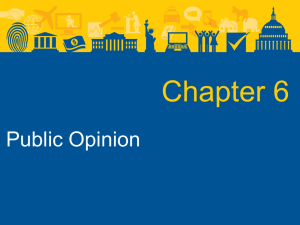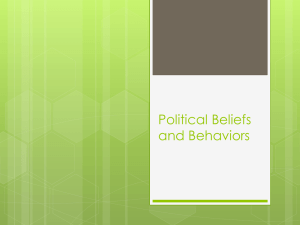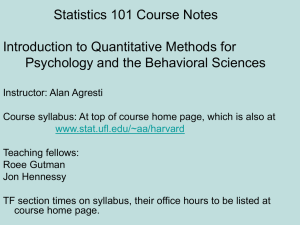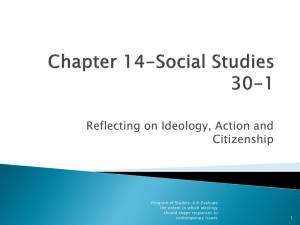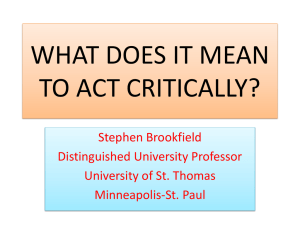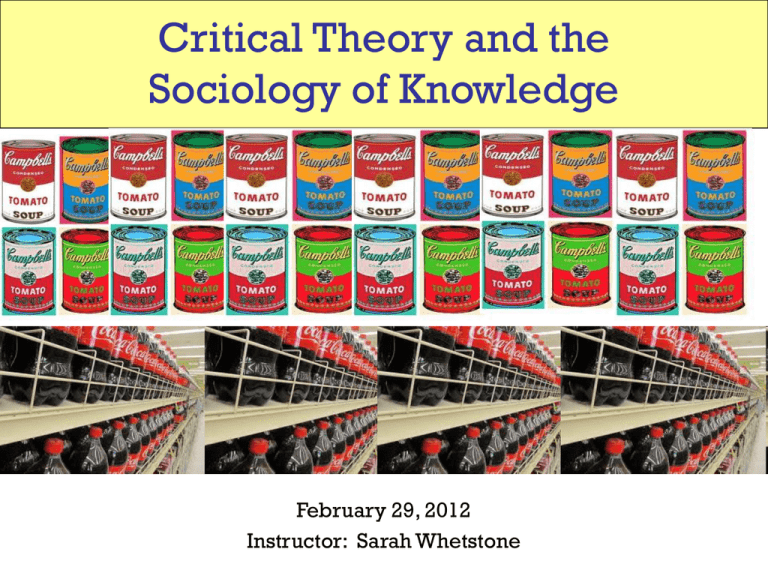
Critical Theory and the
Sociology of Knowledge
February 29, 2012
Instructor: Sarah Whetstone
Key Concepts
• "Ideology and Utopia" - Karl Mannheim
– Particular v. total ideology
– False consciousness
– Ideological v. utopian thought
• "The Culture Industry: Enlightenment as Mass Deception" Horkheimer & Adorno
– Mass culture and culture industry
– Cultural products and consumer desires
– Role of pleasure, meaning of “art,” meaning of “freedom”
• "One-Dimensional Man" - Herbert Marcuse
– Capitalism and “false needs”
– Sublimation, desublimation
– Cycle of stupefaction, Happy consciousness, meaning of “freedom”
• The Merchants of Cool – Frontline documentary
Karl Mannheim and the Sociology
of Knowledge
IDEOLOGY
– includes opinions, statements propositions, and systems of
ideas
– Two types:
• Particular: Representation of things in the world that
might take into account specific interests or points of view.
(one person skeptical of another)
• Total: Entire categories of thought that define how people
see the world around them. (ideas of an era)
– Those with interests attached to certain ideas hold on to them.
– An ideology becomes an ideology when the perspective of a
dominant group is unable to perceive the new facts that have
undermined its social dominance
– Thus, dominant ideology promotes a kind of “false
consciousness.”
Ideological v. Utopian Thought
• Utopian thoughts challenge existing ideologies, threatening
to overturn status quo social order.
•
•
•
•
Ideology and utopia drive social change in a dialectic process
Utopias often thought of as unrealistic
Intellectuals often bearers of utopias
E.g. Christianity, Liberalism, Socialism
• Representatives of the existing order
– Label as “utopian” those ideas that threaten order, and
thus, can never be realized.
– Ex. “universal health care”
• What is defined as ideology vs. utopia depends upon the
interests of the judger. Depends on experience, social
context.
• Both ideology and utopia transcend reality (are not
accurate descriptions of the existing order).
Critical Theory in Sociology
• “Frankfurt School” – 1923 Institute for Social Research
• Influences
– “Neo-Marxism”
• focuses on why class consciousness didn’t develop as predicted by
Marx
• Critiques capitalism not just as a form of economic domination, but
also as a form of cultural domination
– Freudian psychoanalysis: we have deeply suppressed desires
– Weber: importance of ideology in social change; role of
rationalization in social life and the “iron cage”
• Historical context
–
–
–
–
Totalitarianism, bureaucracy on the rise
Promises of Enlightenment unfulfilled
Marxist predictions unfulfilled – no class revolution
Need for new explanations in modernity
Horkheimer & Adorno Art VS. Mass Culture
Horkheimer & Adorno: Homogenization in
the Culture Industry…
•The decline of religion, the dissolution of the feudal order, social
differentiation and specialization have NOT lead to cultural chaos – in fact
“culture now impresses the same stamp on everything…” (385). The
culture industry works to homogenize everyday life.
•We have become cogs in the machine not just as producers but as
consumers.
Horkheimer & Adorno: Art in the Age of Monopoly Capital
– Under monopoly capital (capitalism dominated by megacorporations):
– 1 mass cultural products “all mass culture is identical”
– 2 cultural products don’t have to pretend to be art any more
– 3 they are defined as “business” which in turn justifies the poor
quality of their offerings in terms of market needs and economies
of scale.
decisions of industry
personnel
economies of
scale
e.g. big budget
movies designed
to appeal to
millions
the homogenous
cultural product
“consumer
needs”
What are the effects on how we see “reality”?
• “The whole world is made to pass
through the filter of the culture
industry.”
• Their example: the “sound film” (!)
• Too close to reality – leaving no room
for imagination
• Requires quickness from the
audience but leaves no room for
reflection
• Uses formula and genre to create
automatic expectations of narrative,
etc. which have become
standardized and unchallenging.
True Art Vs. Culture industry products
The art object
Should address universal questions
Art tends to express loss, with desire
itself shown to be a mirage.
Sublimation transforms basic
everyday desires (sex, power, etc)
into more complex registers.
The mass culture product
Follows the principle of amusement,
insulated from deep thought and/or the
broader social implications (the
“totality”)
Gives us the happy ending and the
successful fight – cheap
resolutions/satisfactions
The principles of amusement [pleasure] (389)…
1. Amusement “defends society” – “To be pleased
means to say Yes.”
2. Amusement requires not seeing the “big
picture” (“insulation from the totality of the social
process”)
3. Amusement means not thinking deeply about
anything, especially about forms of suffering
(which might make the audience say “no”)
4. “…it is flight; not… from a wretched reality, but
from the last remaining thought of resistance.”
H & A: The culture industry
creates fake individuality
•Cultural representations shape – How we relate to each other (Ways of talking,
presenting oneself)
– How we understand ourselves (our “inner lives”)
•H&A’s example: Romantic scripts produced and
circulated in the entertainment industry/media
shape our desires and dating practices.
Meaning of Freedom in Capitalist
Consumer Culture
“All are free to dance and enjoy themselves, just as they
have been free, since the historical neutralization of
religion, to join any of the innumerable sects. But
freedom to choose an ideology– since ideology always
reflects economic coercion– everywhere proves to be
freedom to choose what is always the same” (389).
Freedom of Choice?
Herbert Marcuse: One-Dimensional Man
Herbert Marcuse (1898-1979)
• Technological rationality
increases in modernity
• Integration of people into
capitalist consumer thought
necessary for smooth
functioning of “one-dimensional
society”
• Mass consumer culture >
Individuality
• Critiques of Enlightenment,
meaning of liberation
Capitalist Consumer Culture
Produces False Needs
“Most of the prevailing needs to relax, to
have fun, to behave and consume in
accordance with the advertisements, to
love and hate what others love and hate,
belong to this category of false needs.
Such needs have a societal content and
function which are determined by external
powers over which the individual has no
control…(391)”
Sublimation/Desublimation
• Marcuse draws on Freudian logic: Social reality
forces people to discipline their basic impulses
(libido)
• and sublimate the impulses into acceptable
activities (work, recreation, etc.)
• This tension is painful, causes discontent, yet
can also be creative and liberating.
• Capitalist culture allows partial
desublimation– expression of our basic desires
through consumption of cultural products.
Example: Partial Desublimation
One-dimensional man?
Advanced industrial capitalism instills in us a set of “false
needs” via the mass media, advertising, education, etc.
“free choice between
brands and gadgets”
Desublimation
Giving up our liberties in favor of material and sensory candy.
Example: sexuality is a source of “freedom and exploitation.”
Happy Consciousness
Euphoric acceptance that the current system is as good as it gets.
Happy Consciousness!
“The belief that the system delivers the
goods” (i.e. needs and happiness).
Cycle of Stupefaction
• We work until we’re “stupified,” then “relax” with TV.
– Average American watches over 4 hours of TV per day
• Mass culture industry is designed to produce “euphoria in
unhappiness.”
– Advertisements promote having fun, sexuality.
– Ex. Beauty culture, auto culture, white teeth smiles.
– Promote a Happy Consciousness – a false, superficial,
substitution for real happiness, satisfaction, and
fulfillment.
Marcuse’s Liberation
Real human liberation based on
– creative sublimation, demands “high degree of
autonomy & comprehension.”
– A return to “Eros” in all aspects of life: sensual,
spontaneous enjoyment of life.
– Break the “iron cage!”
http://www.pbs.org/wgbh/pages/frontline/shows/cool/view/
Frontline Documentary: The Merchants of Cool
1) What is the “paradox of cool?” How does the film illustrate notions of:
commodification; false needs; one-dimensional man; critiques of
culture, freedom, individuality, authenticity?
2) Homogenization of culture: How are notions of masculinity, feminine
beauty, sex, and “cool” mass produced? Record specific examples.
3) What is “the giant feedback loop?” Is there an escape, according to
the documentary? According to the critical theorists? According to
you?

